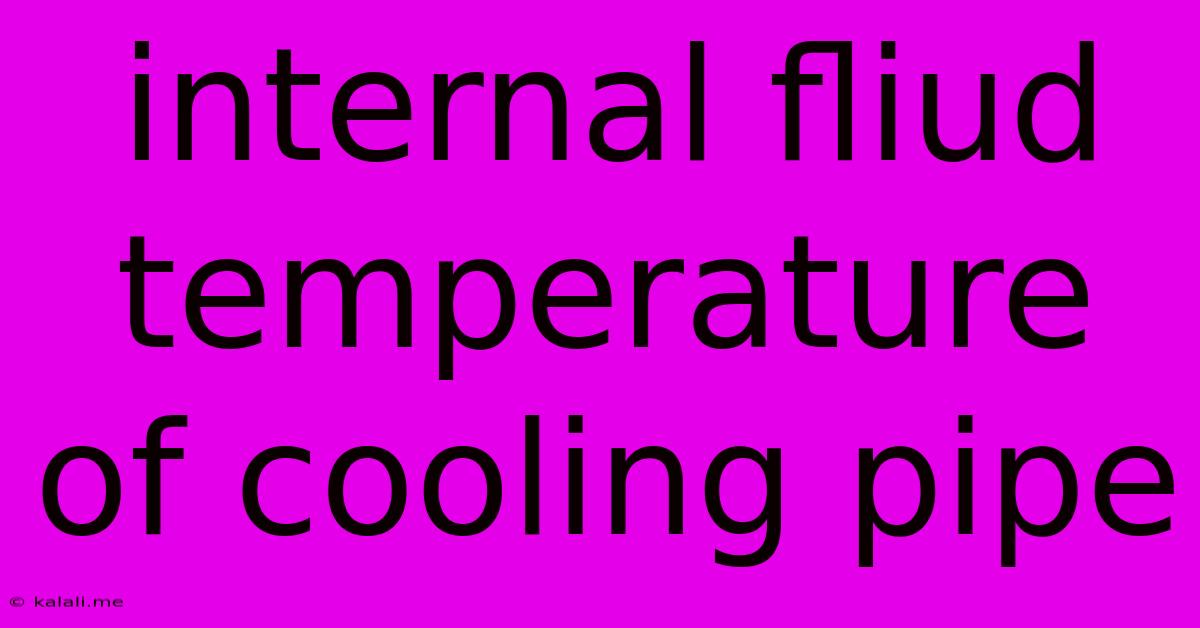Internal Fliud Temperature Of Cooling Pipe
Kalali
Jun 08, 2025 · 3 min read

Table of Contents
Maintaining Optimal Internal Fluid Temperature in Cooling Pipes: A Comprehensive Guide
Maintaining the correct internal fluid temperature within cooling pipes is crucial for numerous industrial processes and applications. From preventing equipment damage to ensuring product quality, precise temperature control is paramount. This article explores the key factors influencing internal fluid temperature in cooling pipes and provides practical strategies for effective management. Understanding these factors is vital for optimizing efficiency and preventing costly malfunctions.
Understanding the Factors Affecting Internal Fluid Temperature
Several factors interplay to determine the internal fluid temperature within cooling pipes. These include:
-
Initial Fluid Temperature: The starting temperature of the fluid significantly impacts the overall cooling process. Higher initial temperatures require more extensive cooling to reach the target temperature.
-
Fluid Flow Rate: A higher flow rate generally leads to more efficient heat transfer, resulting in a lower final temperature. Conversely, a slower flow rate can lead to insufficient cooling and potentially overheating. This is directly related to the fluid's velocity and Reynolds number.
-
Pipe Material and Dimensions: The material of the pipe (e.g., copper, stainless steel, PVC) significantly influences its thermal conductivity. Materials with higher thermal conductivity facilitate faster heat transfer. The pipe's diameter and length also impact the surface area available for heat exchange, influencing the cooling rate.
-
Ambient Temperature: The temperature of the surrounding environment plays a vital role. Higher ambient temperatures will slow down the cooling process, while lower ambient temperatures will accelerate it. This is particularly important in outdoor applications or environments without controlled temperature.
-
Heat Transfer Mechanisms: Heat transfer within the pipe system occurs through convection, conduction, and sometimes radiation. Understanding the dominant mechanisms is essential for optimizing the design and operation of the cooling system. Factors like surface roughness also impact convective heat transfer.
-
Cooling Medium: The choice of cooling medium (air, water, refrigerant) significantly impacts the cooling efficiency. Water, for instance, has a higher specific heat capacity than air, allowing for greater heat absorption.
-
Insulation: The presence and quality of insulation on the pipes directly influence heat loss to the surrounding environment. Proper insulation minimizes heat loss and improves the efficiency of the cooling process.
Strategies for Maintaining Optimal Internal Fluid Temperature
Effective temperature control relies on a combination of design choices and operational practices. Here are some key strategies:
-
Precise Flow Rate Control: Implementing flow meters and control valves allows for precise adjustment of the fluid flow rate, ensuring optimal heat transfer and temperature maintenance.
-
Efficient Pipe Design: Careful selection of pipe materials, diameters, and lengths, optimized for the specific application, can significantly enhance cooling efficiency. Consider using high thermal conductivity materials and optimizing the surface area for heat exchange.
-
Effective Insulation: Applying appropriate insulation materials to the pipes minimizes heat loss to the environment, leading to improved temperature control and reduced energy consumption.
-
Regular Maintenance: Regular inspection and maintenance of the cooling system, including cleaning and addressing any leaks or blockages, is critical for sustained optimal performance.
Advanced Techniques for Temperature Monitoring and Control
For demanding applications requiring highly precise temperature control, advanced techniques may be necessary:
-
Real-time Temperature Monitoring: Employing sensors and data loggers allows for continuous monitoring of the internal fluid temperature, enabling immediate detection and response to any deviations from the setpoint.
-
Closed-Loop Control Systems: Implementing closed-loop control systems integrates temperature sensors with actuators (valves, pumps) to automatically adjust the flow rate and maintain the desired temperature.
-
Predictive Modeling: Utilizing computational fluid dynamics (CFD) simulations can help predict the temperature behavior within the cooling pipe under various operating conditions, allowing for proactive optimization of the system.
By understanding the factors affecting internal fluid temperature and implementing appropriate strategies, you can effectively manage the cooling process, ensure efficient operation, and prevent potential problems. Regular monitoring and maintenance are key to long-term success.
Latest Posts
Latest Posts
-
How Many Years Between Noah And Jesus
Jun 08, 2025
-
Fuelling A Motorcycle Reserve Petcock Open Or Closed
Jun 08, 2025
-
How Difficult Is The First Violin Part For
Jun 08, 2025
-
Water Still Dripping After Shut Off Valve
Jun 08, 2025
-
Do Rotors Need To Be Replaced With Brake Pads
Jun 08, 2025
Related Post
Thank you for visiting our website which covers about Internal Fliud Temperature Of Cooling Pipe . We hope the information provided has been useful to you. Feel free to contact us if you have any questions or need further assistance. See you next time and don't miss to bookmark.